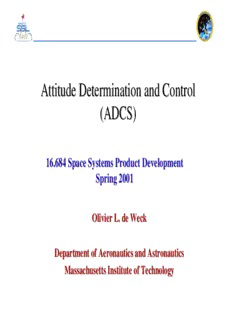Table Of ContentAAttttiittuuddee DDeetteerrmmiinnaattiioonn aanndd CCoonnttrrooll
((AADDCCSS))
1166..668844 SSppaaccee SSyysstteemmss PPrroodduucctt DDeevveellooppmmeenntt
SSpprriinngg 22000011
OOlliivviieerr LL.. ddee WWeecckk
DDeeppaarrttmmeenntt ooff AAeerroonnaauuttiiccss aanndd AAssttrroonnaauuttiiccss
MMaassssaacchhuusseettttss IInnssttiittuuttee ooff TTeecchhnnoollooggyy
AADDCCSS MMoottiivvaattiioonn
(cid:1) Motivation Sensors: GPS, star trackers, limb
—
sensors, rate gyros, inertial
In order to point and slew optical
—
measurement units
systems, spacecraft attitude control
provides coarse pointing while Control Laws
—
optics control provides fine
Spacecraft Slew Maneuvers
(cid:1)
pointing
Euler Angles
—
Spacecraft Control
(cid:1)
Quaternions
—
Spacecraft Stabilization
—
Spin Stabilization
— Key Question:
Gravity Gradient What are the pointing
—
requirements for satellite ?
Three-Axis Control
—
Formation Flight
—
NEED expendable propellant:
Actuators
—
Reaction Wheel Assemblies
— (cid:127) On-board fuel often determines life
(RWAs)
(cid:127) Failing gyros are critical (e.g. HST)
Control Moment Gyros
—
(CMGs)
Magnetic Torque Rods
—
Thrusters
—
OOuuttlliinnee
Definitions and Terminology
(cid:1)
Coordinate Systems and Mathematical Attitude Representations
(cid:1)
Rigid Body Dynamics
(cid:1)
Disturbance Torques in Space
(cid:1)
Passive Attitude Control Schemes
(cid:1)
Actuators
(cid:1)
Sensors
(cid:1)
Active Attitude Control Concepts
(cid:1)
ADCS Performance and Stability Measures
(cid:1)
Estimation and Filtering in Attitude Determination
(cid:1)
Maneuvers
(cid:1)
Other System Consideration, Control/Structure interaction
(cid:1)
Technological Trends and Advanced Concepts
(cid:1)
OOppeenniinngg RReemmaarrkkss
Nearly all ADCS Design and Performance can be viewed in
(cid:1)
terms of RIGID BODY dynamics
Typically a Major spacecraft system
(cid:1)
For large, light-weight structures with low fundamental
(cid:1)
frequencies the flexibility needs to be taken into account
ADCS requirements often drive overall S/C design
(cid:1)
Components are cumbersome, massive and power-consuming
(cid:1)
Field-of-View requirements and specific orientation are key
(cid:1)
Design, analysis and testing are typically the most
(cid:1)
challenging of all subsystems with the exception of payload
design
Need a true “systems orientation” to be successful at
(cid:1)
designing and implementing an ADCS
TTeerrmmiinnoollooggyy
: Orientation of a defined spacecraft body coordinate
AATTTTIITTUUDDEE
system with respect to a defined external frame (GCI,HCI)
Real-Time or Post-Facto knowledge,
AATTTTIITTUUDDEE DDEETTEERRMMIINNAATTIIOONN::
within a given tolerance, of the spacecraft attitude
Maintenance of a desired, specified attitude
AATTTTIITTUUDDEE CCOONNTTRROOLL::
within a given tolerance
“Low Frequency” spacecraft misalignment;
AATTTTIITTUUDDEE EERRRROORR::
usually the intended topic of attitude control
“High Frequency” spacecraft misalignment;
AATTTTIITTUUDDEE JJIITTTTEERR::
usually ignored by ADCS; reduced by good design or fine
pointing/optical control.
PPooiinnttiinngg CCoonnttrrooll DDeeffiinniittiioonnss
target
target desired pointing direction
estimate true actual pointing direction (mean)
estimate estimate of true (instantaneous)
a pointing accuracy (long-term)
c
a s stability (peak-peak motion)
k knowledge error
k true
c control error
s
aa == ppooiinnttiinngg aaccccuurraaccyy == aattttiittuuddee eerrrroorr
ss == ssttaabbiilliittyy == aattttiittuuddee jjiitttteerr
Source:
G. Mosier
NASA GSFC
AAttttiittuuddee CCoooorrddiinnaattee SSyysstteemmss
(North Celestial Pole)
^
Z
GGCCII:: GGeeoocceennttrriicc IInneerrttiiaall CCoooorrddiinnaatteess
CCrroossss pprroodduucctt
GGeeoommeettrryy:: CCeelleessttiiaall SSpphheerree
^ ^ ^
Y = Z x X
h
g t
n
A r c l e
dihedral
(cid:3)(cid:3)
(cid:1)(cid:1)
^
Y
^
VVEERRNNAALL
X
EEQQUUIINNOOXX
(cid:1)(cid:1)(cid:2)(cid:2) IInneerrttiiaall CCoooorrddiinnaattee
:: RRiigghhtt AAsscceennssiioonn
(cid:3)(cid:3) SSyysstteemm
:: DDeecclliinnaattiioonn X and Y are
in the plane of the ecliptic
AAttttiittuuddee DDeessccrriippttiioonn NNoottaattiioonnss
⋅ =
{ } Coordinate system
ˆ
Z (cid:1)
A
=
P Vector
(cid:1) (cid:1)
A A =
P P Position vector w.r.t. {A}
P
z
P
y
ˆ P
Y
x
A (cid:1)
Px AP = P
y
ˆ
X
A
P
z
1 0 0
[ ]
= ˆ ˆ ˆ =
Unit vectors of {A} X Y Z 0 1 0
A A A
0 0 1
Describe the orientation of a body:
(1) Attach a coordinate system to the body
(2) Describe a coordinate system relative to an
inertial reference frame
RRoottaattiioonn MMaattrriixx
Zˆ {A} = Reference coordinate system
A
Jefferson Memorial
Zˆ Yˆ =
B B {B} Body coordinate system
Rotation matrix from {B} to {A}
ˆ
Y
ˆ A [ ]
X
A A = A ˆ A ˆ A ˆ
ˆ R X Y Z
X
B B B B
B
ˆ
Z Special properties of rotation matrices:
A
Jefferson Memorial
Zˆ Yˆ (1) Orthogonal:
B B
θ −
T = T = 1
R R I, R R
θ
ˆ (2) Orthonormal:
Y
A
ˆ ˆ
X X =
A B R 1
1 0 0
(3) Not commutative
A =
R 0 cos -sin
B
A B ≠ B A
R R R R
0 sin cos B C C B
EEuulleerr AAnngglleess ((11))
Euler angles describe a sequence of three rotations about different
axes in order to align one coord. system with a second coord. system.
ˆ α ˆ β ˆ γ
Rotate about Z by Rotate about Y by Rotate about X by
A B C
ˆ
ˆ ˆ ˆ Z
ZA ZB Zˆ ZB Zˆ C
C
D
β γ
ˆ
Y ˆ
Y
B Yˆ D
B γ
α
ˆ
Y ˆ
ˆ A X ˆ
X B β Y Yˆ
A α C
C
ˆ ˆ
X X ˆ ˆ
X X
B C
C D
cosα -sinα 0 cosβ 0 sinβ 1 0 0
A = α α B = C = γ γ
R sin cos 0 R 0 1 0 R 0 cos -sin
B C D
β β γ γ
0 0 1 -sin 0 cos 0 sin cos
A = A B C
R R R R
D B C D
Description:ATTITUDE : Orientation of a defined spacecraft body coordinate system with respect to a defined external frame (GCI,HCI). ATTITUDE DETERMINATION: Real-Time or Post-Facto knowledge, within a given May cause harmful influence on .. 35 pounds, 15 Watts, 200K words, 100 Kflops/sec, CMOS.

